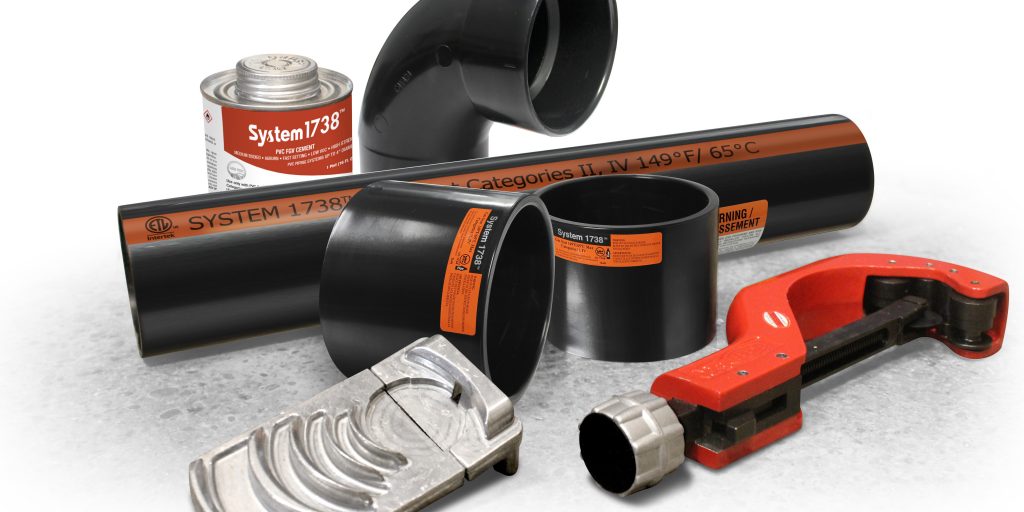Avoid Natural Gas Venting Problems: The right thing to do, is the safe thing to do
As the first engineered PVC Flue Gas Venting System certified to the UL 1738 standard for categories II and IV gas burning appliances, System 1738® from IPEX helps protect against the dangers of carbon monoxide.
No one would deny the absolute importance of life safety in the places where we live, work and play in our communities. Furthermore many, if not most, of our homes, schools, offices and other buildings where people congregate rely on natural gas for warmth in winter and an abundant supply of hot water. And it would be perfectly understandable if one were to assume that every precaution would be taken to ensure the safety of people, and guard against the possibility of exposure to carbon monoxide gas leaks. Unfortunately, this is usually not the case.
Every year, we hear terrible stories in the news of families being exposed to carbon monoxide, often with tragic results. The root causes of these tragic occurrences can range from faulty or poorly maintained equipment, to CO detectors not working, to improper use of gas burning equipment. But there is one possible cause that doesn’t often get the scrutiny it probably deserves; the venting system of the heating appliance. Too often, the heating system fails because the vent material and system installation are inadequate.
In 2014, the Consumer Product Safety Commission reported that there were 165 non-fire related CO poisoning deaths, an increase of 11% from the average number of reported incidents between 2012-2013, and of these reported incidents, heating system fatalities represented the largest percentage at 39% or 65 deaths.1 Some examples of vent failures that contributed to these statistics by exhibiting either embrittlement, material degradation or vent separation were reported and documented in Aspen Colorado, Nashua New Hampshire, South Bend Indiana and Port Mouth Virginia.2
The reality is that, today, there is a life safety issue that should be of concern to everyone. It involves the use of plumbing Solid Wall Schedule 40 or Foam Core Drain, Waste and Vent (DWV) pipe and fittings certified to ASTM Plumbing Standards in Flue Gas Venting (FGV) applications. Simply put, plumbing DWV products are NOT designed to meet the life safety standards of FGV applications and were never intended to be used in FGV applications.
To be fair, current codes governing FGV systems across the United States still allow for the use of DWV pipe and fittings to be used in FGV applications, and, certified FGV alternatives have only just recently been developed, approved and available on the market.
System 1738® by IPEX is one such FGV system designed to safeguard against the dangers of carbon monoxide.
Accompanied by an industry-leading, 10-year Product Warranty, System 1738® is the first engineered PVC Flue Gas Venting system certified to UL 1738. Rated for flue gas temperatures up to 149oF (65oC), it is a complete system consisting of pipe, fittings, termination kits and solvent cement manufactured to strict quality, performance and dimensional standards. It is available in 2”, 3” and 4” diameter pipe and fittings.
To achieve UL 1738 certification, it underwent extensive testing consisting of system performance requirements and material conditioning and test requirements. The rigorous certification process also included approval of all installation instructions and special marking and labelling requirements for FGV pipe, fittings and cement.
System 1738® pipes and fittings are black in color. Material type, application and temperature rating are included in the pipe print as well as on the orange and black certification labels applied to each fitting. All System 1738® products have been certified by Intertek, a leading 3rd party certification agency, and carry an ETL mark as proof of certification. As required by the UL 1738 Standard, markings on pipe and fittings clearly differentiate it as a certified gas venting system from everyday, ASTM-certified plumbing pipe and fittings.
Additionally, System 1738® solvent cement is specifically formulated and certified for flue gas venting applications to provide permanent welded joints, and includes an optical brightener that is visible under a UV light for identification of the proper cement for the application. Primers are also available for applications where the system is to be installed in temperatures below 32oF (0oC). Cutting and deburring tools are also available as part of the comprehensive flue gas venting system.
Perhaps it’s time to update the code to specify UL certified flue gas venting systems.
In 2009, Colorado was the first state to mandate the installation of carbon monoxide detectors in new home construction. Today, 27 states and the District of Columbia require carbon monoxide detectors in private dwellings, with another 11 states requiring CO detectors in private dwellings either through adoption of the International Residential Code or through changes to existing codes.
Given that UL certified venting systems are now available, maybe state and local governments, through their respective AHJs, should consider updating their codes to specify the use of UL 1738 certified venting systems.
When it comes to safety, there is no room for compromise.
Reducing the risk of unintended exposure to carbon monoxide is the top priority for manufacturers, contractors and government officials alike. In fact, both the NFPA 54-18 and IFGC Fuel Gas Codes now recognize the UL 1738 venting standard across the United States.
Carbon monoxide detectors are an essential 2nd line of defense to protect against the dangers of carbon monoxide, but our 1st line of defense should be to always use a UL 1738 certified flue gas venting system like System 1738®. Updating the code to reflect these advancements in FGV technology would represent a significant step forward in helping to ensure public safety. And, quite simply, because it’s the right thing to do.




















